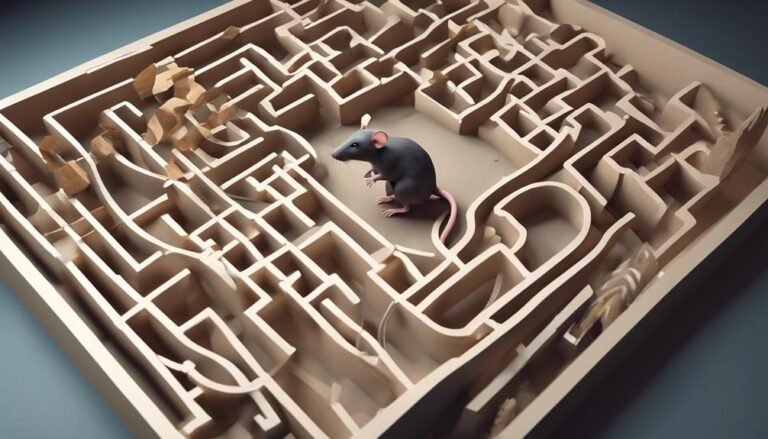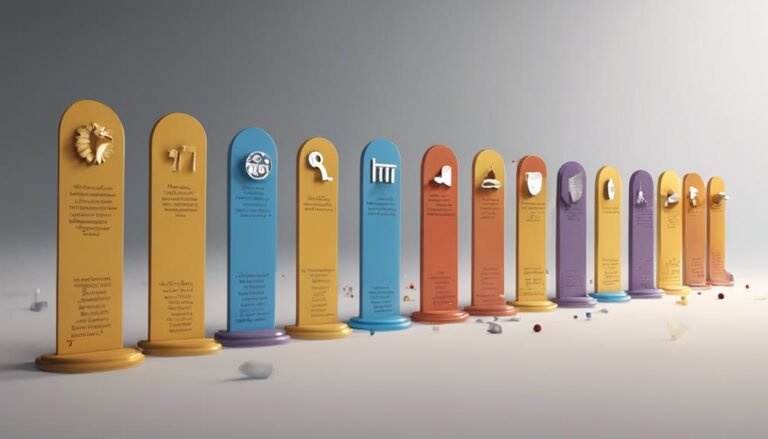The Rorschach Inkblot Test
You may not know that the Rorschach Inkblot Test has been a subject of intrigue and controversy in the field of psychology for decades. As you consider this psychological assessment tool, think about the intricate ways in which individuals' responses to seemingly abstract images can provide deep insights into their innermost thoughts and emotions. The complexity and depth of interpretation involved in analyzing these inkblots offer a fascinating glimpse into the human psyche, raising questions about the intricacies of perception and personality assessment.
Key Takeaways
- Developed by Swiss psychiatrist Hermann Rorschach.
- Features ten symmetrical inkblot images for psychological assessment.
- Validity of the test subject to ongoing debate.
- Cultural sensitivity crucial for diverse populations.
- Clinical applications and diagnostic effectiveness evolve over time.
History of the Rorschach Test
The history of the Rorschach Test began in the early 20th century with the pioneering work of Swiss psychiatrist Hermann Rorschach. This psychological assessment tool, with its ten symmetrical inkblot images, was designed to explore the human psyche.
The test's validity has been a subject of ongoing debate, with some praising its ability to reveal underlying personality traits, emotional functioning, and thought disorders, while others criticize its lack of standardization and objectivity.
The cultural impact of the Rorschach Test has been profound, influencing fields beyond psychology, such as art, literature, and popular culture. Its administration requires a trained psychologist or psychiatrist who guides the individual through the process of interpreting the ambiguous inkblots.
Symbol interpretation is a key aspect of the test, as respondents project their thoughts, emotions, and inner conflicts onto the inkblots, revealing unconscious aspects of their personality.
Over time, the Rorschach Test has become a widely recognized tool in psychological assessments, despite ongoing discussions regarding its reliability and utility in modern clinical practice.
Hermann Rorschach's Contribution
Hermann Rorschach's pioneering work revolutionized the field of psychology with the development of the inkblot test. His creation has had a significant psychological impact, paving the way for a range of clinical applications.
Rorschach's inkblot test has been widely used as a personality evaluation tool, offering insights into individuals' thoughts, emotions, and perceptions.
The inkblot test isn't merely a diagnostic tool but a thorough method for understanding the intricacies of human cognition and behavior. By presenting ambiguous stimuli to individuals, the test elicits responses that can be analyzed to uncover underlying personality traits, thought processes, and potential psychological issues.
The test's versatility in evaluating various aspects of an individual's psyche has made it invaluable in clinical settings, aiding psychologists in formulating accurate diagnoses and treatment plans.
Rorschach's contribution to psychology through the development of the inkblot test has left a lasting impact on the field, solidifying its place as a fundamental tool in psychological evaluation and understanding.
Inkblot Test Development
Development of the inkblot test involved rigorous experimentation and refinement to establish its validity and reliability as a psychological assessment tool. Test validity was a primary focus during the development process, ensuring that the inkblots could consistently measure what they were intended to assess.
Cultural factors played an essential role in the refinement of the test, with researchers working to create inkblots that were culturally sensitive and applicable across diverse populations.
The inkblot test's clinical applications have evolved over time, with researchers continuously exploring new ways to utilize the test in various psychological assessments. Research trends in recent years have focused on the effectiveness of the inkblot test in diagnosing specific mental health conditions and predicting treatment outcomes.
Additionally, there's been an increase in studies examining the role of cultural factors in influencing individuals' responses to the inkblots, further enhancing the test's applicability in a global context.
Administration Techniques
When administering the Rorschach Inkblot Test, it's vital to follow specific setup instructions to guarantee consistency and reliability in the testing process. You should carefully record the participant's responses to each inkblot, noting their initial impressions and any subsequent elaborations.
Proper scoring and interpretation techniques are essential in analyzing the test results accurately and drawing meaningful conclusions about the individual's psychological state.
Test Setup Instructions
To guarantee the accuracy of the results, meticulous attention to detail in the preparation and administration of the Rorschach Inkblot Test is essential. Participant preparation plays a significant role in ensuring the reliability of the test outcomes. Before beginning the assessment, it's important to provide clear instructions to the participant regarding the nature of the test and what's expected of them during the process.
Additionally, configuring the test environment is key to creating an atmosphere conducive to accurate responses. Make sure the room is quiet and free from distractions to allow the participant to focus entirely on the inkblots presented to them. Proper lighting is also crucial to ensure the inkblots are visible without causing strain on the participant's eyes.
Participant Response Recording
For guaranteeing effective administration of the Rorschach Inkblot Test, precise techniques for recording participant responses are paramount. Response analysis is a critical component of the test, as it provides insight into the individual's visual perception and image interpretation.
When recording participant responses, it's essential to document not only what they see in the inkblots but also how they arrived at those interpretations.
To maintain accuracy in response recording, psychologists often use standardized forms that prompt participants to describe their perceptions in detail. These forms typically include sections for participants to write down their immediate thoughts upon viewing each inkblot, allowing for a real-time capture of their responses.
Additionally, psychologists may make audio recordings during the test to further document the participant's verbalizations and nuances in their reactions.
Scoring and Interpretation
Effective scoring and interpretation of the Rorschach Inkblot Test requires careful consideration of administration techniques that align with standardized protocols for analyzing participant responses. Test reliability and validity are critical factors when scoring and interpreting the results. Ensuring scoring accuracy and consistency is essential for obtaining valid insights into an individual's psychological profile.
To enhance scoring accuracy, it's imperative to follow established guidelines and use standardized scoring systems. Consistency in scoring methodologies across different evaluators is crucial to maintain the test's reliability. By adhering to these standardized protocols, psychologists can minimize subjective biases and increase the test's validity.
Training in Rorschach administration techniques is paramount to ensure accurate scoring and interpretation. Psychologists must possess a deep understanding of the scoring criteria and be adept at recognizing nuanced responses. Regular calibration sessions among evaluators can further enhance scoring consistency and reliability.
Interpretation Guidelines
When analyzing the Rorschach inkblots, it's crucial to take into account the symbol meanings attributed to different responses. These symbols can provide valuable psychological insight into the individual's personality, emotions, and thought processes.
Symbol Meanings
Understanding the symbol meanings in the Rorschach Inkblot Test entails a structured approach that involves examining the various interpretations associated with different shapes and forms perceived by the individual.
Symbol interpretation in this test explores subconscious meanings, revealing hidden messages that the individual mightn't be consciously aware of.
Each inkblot presents a series of shapes and forms that can be perceived differently by different individuals.
Psychologists trained in the use of the Rorschach test look for symbolic associations within the responses provided by the test-taker. These associations can provide valuable insights into the person's thought processes, emotions, and underlying psychological states.
By analyzing the symbolic meanings attributed to the inkblots, psychologists can gain a deeper understanding of the individual's inner world and uncover aspects of their personality that may not be readily apparent through other means of assessment.
The interpretation of these symbols requires a careful consideration of the test-taker's responses and the broader context of the individual's psychological makeup.
Psychological Insight
For an in-depth analysis of the Rorschach Inkblot Test results, psychologists utilize specific interpretation guidelines to extract valuable psychological insights from the test-taker's responses. These guidelines are essential in understanding the test-taker's perceptions and thought processes. Through clinical applications, psychologists can identify patterns in the responses that may indicate underlying psychological conditions or personality traits.
Artistic interpretations play a significant role in the analysis of the Rorschach test. Psychologists often consider the creativity and originality of the responses, looking for unique or unconventional interpretations that may reveal aspects of the test-taker's personality.
Moreover, cultural influences and societal perceptions also play a crucial role in interpreting the results of the Rorschach test. Different cultures may perceive the inkblots differently, leading to varied responses. Psychologists take these factors into account when analyzing the test results to ensure a thorough understanding of the test-taker's psychological makeup.
Interpretation Techniques
To effectively analyze the results of the Rorschach Inkblot Test, psychologists rely on specific interpretation guidelines that outline key techniques for extracting meaningful psychological insights. Interpretation challenges arise due to the subjective nature of the test, where responses can vary widely between individuals. Psychologists must be mindful of their own personal biases that could influence their interpretation of the inkblots. Cultural influences also play an important role in how individuals perceive and interpret the images, making it essential for psychologists to take into account the cultural background of the individual being tested.
When interpreting the responses to the inkblots, psychologists look for symbolic representations that can provide clues to the individual's thoughts, emotions, and underlying psychological characteristics. Understanding the symbolic meanings behind the responses requires a deep understanding of psychological principles and an ability to connect seemingly random shapes to meaningful psychological constructs.
Psychological Insights Revealed
Examining the responses to the Rorschach Inkblot Test provides psychologists with valuable insights into an individual's thought processes and emotional functioning.
Through the symbolic representation and subconscious exploration revealed in the personalized perceptions of the inkblots, hidden emotions can be brought to the surface for analysis.
The test allows psychologists to explore the depths of the test-taker's mind, offering a window into their inner world that may not be easily accessible through other means.
Criticisms and Controversies
Critics have raised concerns regarding the reliability and validity of the Rorschach Inkblot Test in evaluating personality traits and psychological states. Some argue that the test lacks standardization, leading to subjective interpretations by different clinicians. This variability in scoring and analysis raises validity issues, as the results may not be consistently reproducible across different evaluators.
Additionally, ethical concerns have been raised about the test's potential to pathologize normal variations in responses. Critics assert that the emphasis on unconscious processes in the Rorschach test may lead to overinterpretation and misdiagnosis.
Despite these criticisms, the Rorschach test continues to have clinical applications, especially in providing supplementary information in complex cases where traditional assessments may fall short. Its use in forensic psychology and evaluating thought disorders showcases its enduring relevance in specific contexts.
Moreover, the test's portrayal in pop culture has both fueled fascination and perpetuated misconceptions about its utility and accuracy. It remains essential to critically evaluate the Rorschach Inkblot Test within the context of its limitations and controversies.
Modern Applications in Assessment
What're the current modern applications of the Rorschach Inkblot Test in psychological evaluation?
The Rorschach Inkblot Test continues to find relevance in various clinical applications, serving as a tool for evaluating personality characteristics, emotional functioning, and thought processes. Through advanced data analysis techniques, psychologists can derive valuable insights from the responses provided by individuals taking the test.
Technological advancements have further enhanced the administration and interpretation of the Rorschach test, making it more accessible and efficient. Digital platforms now allow for standardized evaluation and scoring, ensuring consistency in the assessment process.
These advancements have also opened up new avenues for research, enabling larger datasets to be analyzed and contributing to a deeper understanding of the test's psychometric properties.
The implications of ongoing research into the Rorschach Inkblot Test are significant, as they provide valuable information on its reliability and validity in contemporary psychological evaluation. By embracing technological innovations and incorporating rigorous data analysis methods, the Rorschach test continues to evolve as a valuable tool in psychological evaluation.
Cultural Considerations in Testing
Considering the diverse cultural backgrounds of individuals undergoing psychological evaluation, it's vital to address the impact of cultural considerations in administering the Rorschach Inkblot Test. Cultural biases can greatly influence how individuals perceive and interpret the inkblots, potentially impacting the validity of the test results.
Interpretation of the inkblots can vary based on cultural upbringing, experiences, and norms, leading to different responses from diverse populations. To guarantee the test's validity across cultural groups, psychologists need to be mindful of these potential biases and adapt their approach accordingly.
This may involve considering the cultural relevance of the inkblots, understanding how certain symbols or colors may hold different meanings in various cultures, and being sensitive to how individuals from different backgrounds might approach the test.
Incorporating cultural considerations in testing helps enhance the test's accuracy and effectiveness, allowing for a more thorough evaluation of individuals from diverse backgrounds. By acknowledging and addressing cultural influences on interpretation, psychologists can better navigate the complexities of administering the Rorschach Inkblot Test within a context of cultural diversity.
Future of Inkblot Analysis
The future of inkblot analysis holds promising advancements in enhancing the test's diagnostic precision and utility across various psychological assessments.
Inkblot technology is evolving, with the potential for virtual assessment becoming more prevalent. This shift towards virtual platforms allows for greater accessibility and flexibility in administering and scoring the Rorschach Inkblot Test.
AI analysis is also making strides in inkblot interpretation. Artificial intelligence algorithms can process and analyze inkblot responses efficiently, providing insights into cognitive processes and emotional functioning. By incorporating AI into inkblot analysis, psychologists can benefit from more standardized and objective interpretations, reducing the potential for human bias.
Moreover, the integration of AI can lead to the development of predictive models based on large datasets. These models could enhance the accuracy of diagnostic outcomes and provide valuable information for treatment planning.
As technology continues to advance, the future of inkblot analysis holds immense potential for revolutionizing psychological assessments and improving clinical practice.
Conclusion
You've explored the enigmatic world of the Rorschach Inkblot Test, peering into the depths of the human psyche through ink-stained visions. With its rich history, controversial interpretations, and modern applications, this psychological tool continues to captivate and intrigue.
The future of inkblot analysis promises even deeper insights into the complexities of the mind, offering a window into the hidden domains of personality and perception. The inkblots beckon, inviting you to explore the depths of the unknown.







